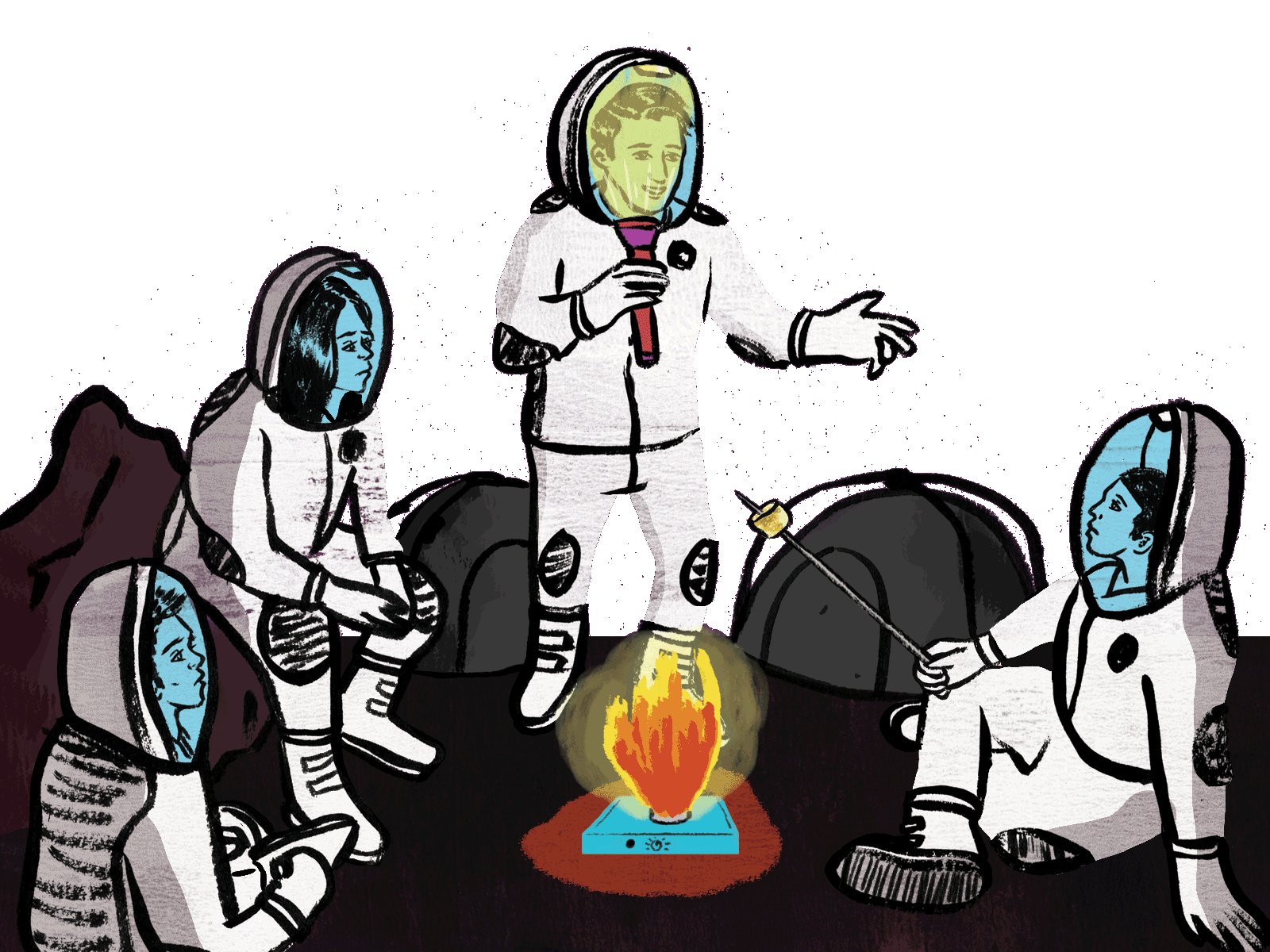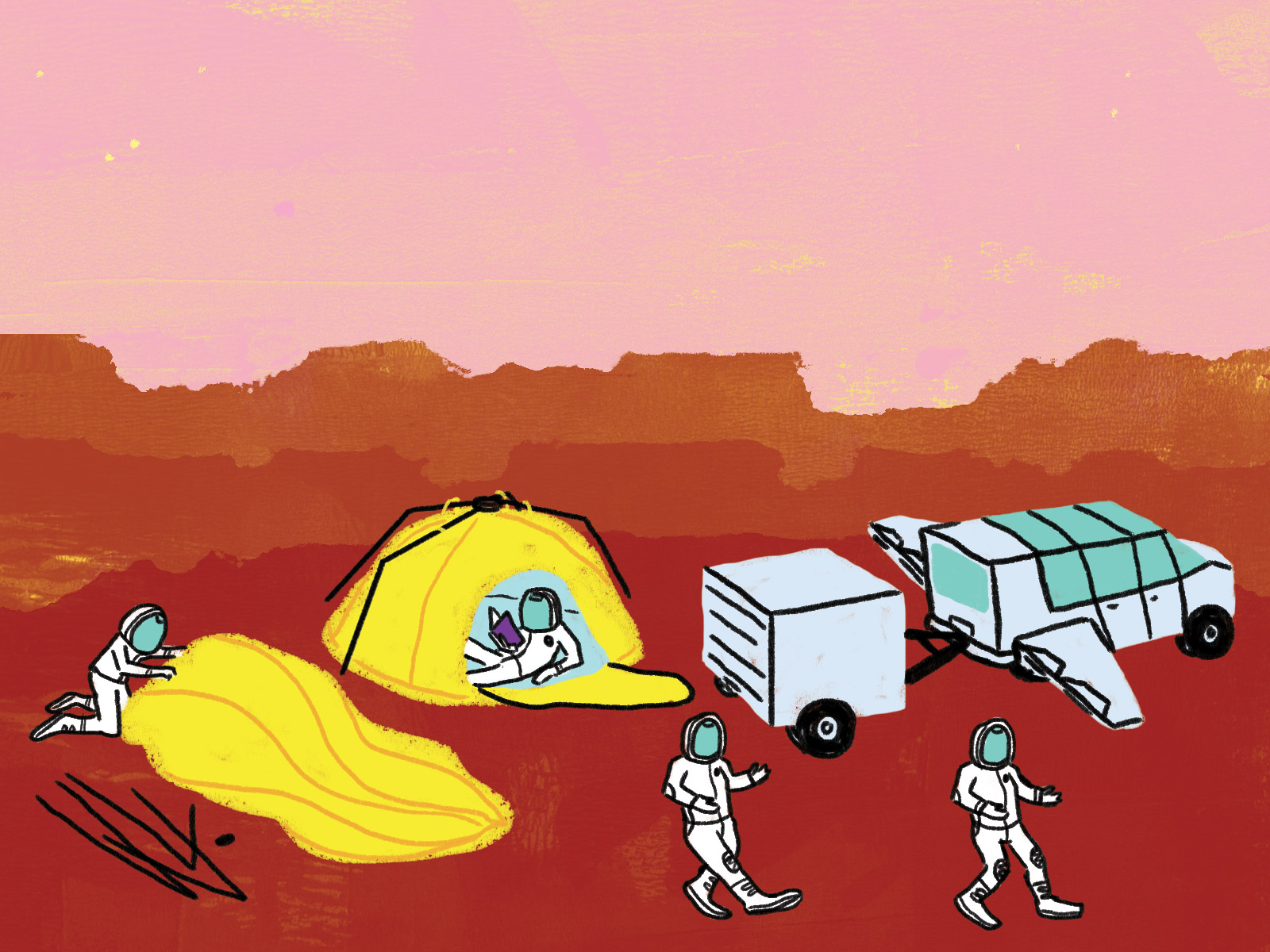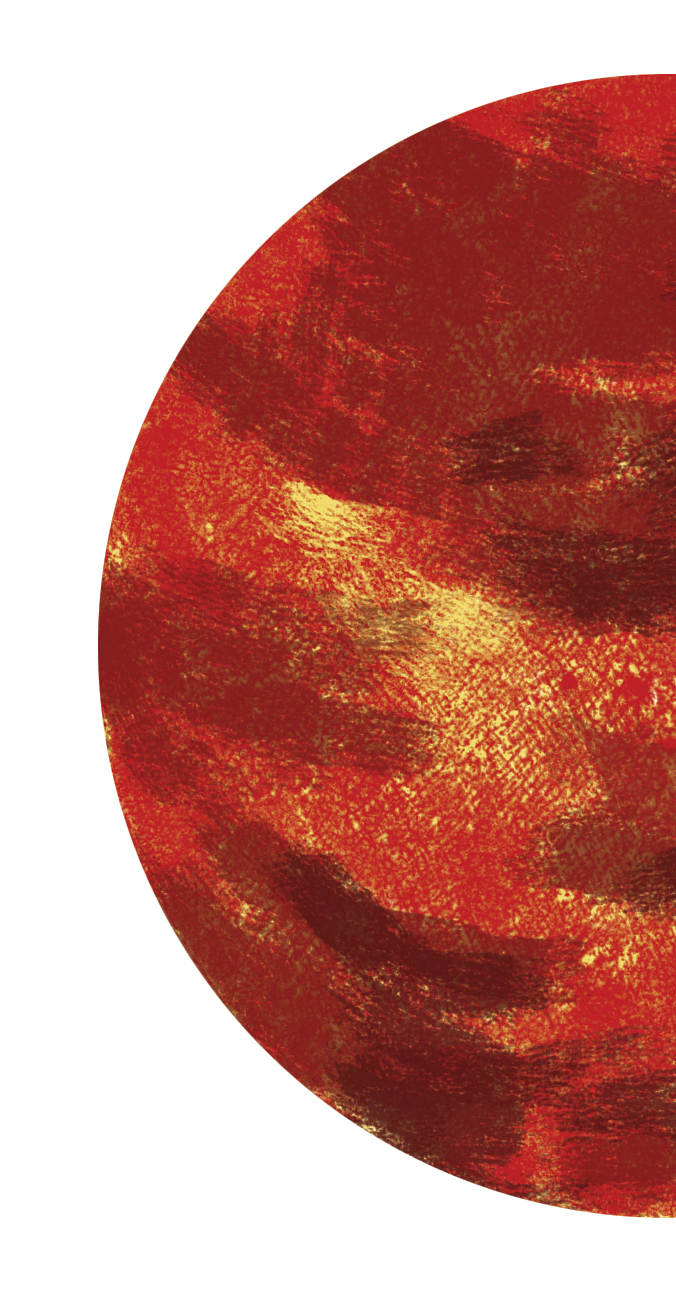Mission
to Mars
Getting to the Red Planet is a lot more than just rocket science. Management Professor John Mathieu '80 (CLAS) is working with NASA on the human mechanics.
By Pete Nelson "¢ Illustrations by Daniel Fishel
By Pete Nelson
Illustrations by Daniel Fishel

Most people understand, sometimes in the sixteenth hour of a drive home from a family summer vacation waiting in bumper-to-bumper traffic to get through the tollbooths and across the George Washington Bridge in a hot, crowded car with a malfunctioning air conditioner, that there are limits to human compatibility. It usually goes something like this:
"Why did we go this way? The other way would have been faster."
Most people understand, sometimes in the sixteenth hour of a drive home from a family summer vacation waiting in bumper-to-bumper traffic to get through the tollbooths and across the George Washington Bridge in a hot, crowded car with a malfunctioning air conditioner, that there are limits to human compatibility. It usually goes something like this:
"Why did we go this way? The other way would have been faster."
"Thank you so much for helping me drive! I have an idea: Why don't we just go back in time two hours and make a different decision about what road to take?"
"I have to go to the bathroom."
"I'm going to throw up."
So imagine, instead of an all-day family car trip with frequent rest stops, you'll be traveling for three years and 500 million miles with five strangers, no rest stops, and no chance to get away from one another — and just to keep you on your toes, you could die any minute. This is essentially the problem Management Professor John Mathieu has been given to solve, tasked by NASA to research how the six-man team they hope to send to Mars in 2036 (or so) can not only survive the journey, but thrive and excel.
"How do you help a team in an LDSE [long-duration space exploration] environment," Mathieu says, "sustain its effectiveness in the long term? What's the right mix of people to put in, basically, a room for three years? Twelve months to get there, twelve months on the surface, and another twelve months back."
That three-part mission, getting ready, getting there to do the mission, and getting home, is compounded in the first phase by the probability that the team we send ("we" meaning "Earth") will comprise individuals chosen by the five or six different countries it's going to take to finance such a project, scientists with no proven prior compatibility and relatively little time to train or acclimate to one another before the launch.
"The most likely scenario," Mathieu says, "is that there will be a U.S. person, and someone from Russia — if we're getting along with Russia at the time, and probably a European, and a Japanese astronaut, and maybe one or two other people. We quickly realized, we can't control who the other countries are going to send, so we pivoted from how do you optimize the mix, to how do you index the quality of the mix you get? Where is it a good fit versus where might there be some rifts? Where might there be differences in orientation?"
John Mathieu is a Professor of Management and holds the Friar Chair in Leadership and Teams at UConn. His primary areas of interest include models of team and multi-team effectiveness, leadership, training effectiveness, and cross-level models of organizational behavior. He has conducted work with several Fortune 500 companies, the Armed Services (Army, Navy, and Air Force), federal and state agencies (NRC, NASA, FAA, DOT), and numerous public and private organizations. Professor Mathieu is a Fellow of the Society for Industrial/Organizational Psychology, American Psychological Association, and the Academy of Management, and he serves on numerous editorial boards.

"If you have to live with me in a box for three years, those no-biggie roommate issues are suddenly going to be consequential."
Type A+
The Mars mission astronauts selected by their home countries will be the best of the best, technically skilled and equally gifted with the kind of ego required to have the self-confidence they need. At the same time, a team of all-stars is not as important as having colleagues who prioritize team cohesion over personal accomplishment.
"You have to have people who are very comfortable being by themselves and isolated, yet also comfortable working collaboratively on a team, because what they have to do is going to be a combination of both," says Mathieu. "There's going to be an awful lot of solo work. The combination of being good alone, versus working collaboratively — people tend to fall on one side or the other of the spectrum. It's a unique population that can do both."
Mathieu is reluctant to take sports metaphors too far, but working from an office on the UConn campus in Storrs where the walls are filled with framed sports pages featuring the Boston Red Sox, Mathieu (himself a kind of Jason Varitek, savvy and solid like the retired all-star catcher) agrees that what you want might be someone like second baseman Dustin Pedroia.
"He has an awful lot of the attributes you'd be looking for," Mathieu says. "He tries to build other people around him. He grits things out. You get everything from him, every day. But if you watch him closely, you'll see him try to develop other people. You'll see him managing the dugout. He's the one who pulls his teammate away from the umpire when they're having a hot moment. He is the ultimate team guy."
At the same time, you don't necessarily want six copies of the same person. Once the team members are known, Mathieu's research will help assess each individual to determine which role he or she is best suited for, and then train them for that role. Mathieu has identified the participants any team needs to be successful. You need an Organizer who pays attention to accomplishments and whether or not the team is progressing toward set goals on schedule; a Doer who rolls up his or her sleeves and turns to-do lists into done lists; a Challenger who questions assumptions, critiques ideas in a productive way, and proposes alternative solutions to problems; an Innovator who can think divergently and offer creative right-brain proposals when linear thinking leads to dead ends; a Team Builder who is supportive and positive and calm when others are stressed or down; and finally you need a Connector, attentive to the team's interpersonal relationships or frictions who also serves as a bridge to authorities outside the team.
"There's a lot of moderates in the right person," Mathieu says. "You want somebody who's conscientious, so you have planning and timeliness, but you don't want someone who's so rigid that they drive you crazy. You want them to be agreeable but not too agreeable. You want them to be stable, but you don't want them to be Mr. Spock from "Star Trek." You'll want to be able to see some emotion."
Detecting and interpreting those emotions gains importance in the second phase of the mission, when the training is over and the team leaves Earth's atmosphere, where the more challenging job of team maintenance begins. The team will need to be self-sustaining and self-correcting, but to do that, you need to be able to self-assess and self-monitor, which is more difficult. Mathieu and his research partners have developed tools to assist.
One is a device astronauts might wear called a Sociometric Solutions Badge, about the size of a cellphone, that can measure things like movement, proximity to others, and changes in vocal tone and inflection; it would detect when someone is stressed or upset, talking over a teammate, or spending too much time alone. In twenty years, the technology needed to measure such things will surely exceed what we have now.
"Certain kinds of signatures or patterns might signal that the team is starting to unravel a bit, so maybe it would be worthwhile to trigger an intervention or some remedial kind of action." The badges will monitor the team in a way that's unobtrusive. "You don't want to be Big Brother. These folks don't want to be monitored 24/7."
But how do you intervene when there are no therapists on board and you can't get outside help? Mathieu's other tool, to head off problems before they escalate, is a program called Debrief Now, a kind of psycho-emotional survey astronauts can take, using an iPad or touchscreen, that will help them identify what kinds of things need to be addressed. In the futures we often see in science fiction, our big-brained selves have evolved to transcend our frailties and petty annoyances; in reality, that's probably not going to happen.
"There will be a lot of roommate issues. Here on Earth," Mathieu says, "I could go to lunch with someone, and I might make some noise when I eat, and the other person might notice it and not like it, and think it was irritating, but it's no biggie because it's just lunch. If you have to live with me in a box for three years, those roommate issues are suddenly going to be consequential.
"I ask questions like 'Do I think we make decisions in a timely fashion? Do I have the proper amount of input in the decisions that we make? Are the joint meals enjoyable? Am I having trouble sleeping? Are the sleeping arrangements working well?' In real life, we tend not to talk about icky things. The things that may be troubling you, or may be troubling me, some difficulty dealing with one another on some joint task, we tend not to talk about it. And then when we do, it tends to unravel pretty quickly."

"So imagine instead of an all-day family car trip with frequent road stops, you'll be traveling for three years and 500 million miles with five strangers and no rest stops."
Suggestion Box
Astronauts will be able to use the tool anonymously. In a factory on Earth with a thousand employees, a disgruntled employee can drop a complaint in the suggestion box and remain anonymous, but on a space transport with a crew of six, it's not so easy. Previous research has shown that the degree to which a team member feels valued, with a sense of belonging and a belief that his contributions to the team are making a meaningful impact, depends on something called "voice climate," or the extent to which a team member feels free to speak, free to make suggestions or admit to mistakes without suffering judgments or repercussions, and that their words will be heard and fairly considered.
"It's a venting tool, in a sense, but we prefer to think of it as providing a safe environment to express your concerns," Mathieu says. "It's not just a bitch-form. That's not productive for anybody. But it's different if someone says, 'Look — we always make snap decisions and we never think through all the consequences.' The surface of it is, how do we make decisions? How do we make sure we don't prematurely close off options? We have discussion prompts that will get them talking about those kinds of things rather than letting it get to the point where someone says, 'Dammit — why do we always do what you want to do?'"
The other reason to debrief is to understand mistakes when they happen, before camps or sub-coalitions form to divide teams, which may then cause blame-shifting and scapegoating.
"Being willing to admit things is a sign that it's a safe environment," Mathieu says. "Nobody is going to take your head off. You want to do all you can to prevent mistakes, but if those things do happen, you want to be able to process it in a productive fashion. When you don't, people try even harder to not engage or to avoid problems, and it creates a negative spiral that can be very difficult to get out of."
So far, Mathieu and his research partners have been looking at Earth analogs to collect data, high-stress, real-life teams like submarine crews, Antarctic researchers, surgical teams, or the saturation divers working on deep sea oil rigs. There are also designated NASA research sites, an actual space capsule in a hangar in Houston where individuals can be confined and studied and an underwater training facility off the coast of Florida called NEMO where astronaut candidates in buoyancy suits can work for long periods in simulated zero gravity. At the same time, nothing can really simulate a mission to Mars, where evacuation is impossible and there aren't any referees.
"There's going to be some higher-level guy at NASA in a supervisory role, a director who you can defer to," Mathieu notes, "but usually it's a failure if you have to defer to them."
If it works, and team cohesion is optimized, the result is synergy and what some refer to as flow, a state of sublime grace when the team becomes a perfect fusion of talents, greater than the sum of its parts. When that happens, verbal communication is sometimes unnecessary.
"You can see it when surgical teams are operating at peak efficiency — there's almost an icy silence," Mathieu says.
The third phase of the journey, the trip home, may be most challenging of all, because after the excitement is over, the boredom sets in.
"There will probably be some just-in-time training, where you stagger the training so that the astronauts only get it two months before they need it. On the trip back, NASA may schedule other activities or experiments. The idea is to keep the astronauts engaged with something that's meaningful. And throughout the mission, there will be scheduled down time. A lot of what they do depends on the individual. Listening to music, watching movies, video games, leisure-time pursuits that are good for them. What makes you happy? What approximates normal life?"
Mad-Libs and the Alphabet Game? Could sociometric monitoring devices or Mathieu's Debrief Now tool prevent a family from fighting on the drive home from summer vacation? Hard to say. We can put people on Mars, but some things may simply be impossible.
John Mathieu is a Professor of Management and holds the Friar Chair in Leadership and Teams at UConn. His primary areas of interest include models of team and multi-team effectiveness, leadership, training effectiveness, and cross-level models of organizational behavior. He has conducted work with several Fortune 500 companies, the Armed Services (Army, Navy, and Air Force), federal and state agencies (NRC, NASA, FAA, DOT), and numerous public and private organizations. Professor Mathieu is a Fellow of the Society for Industrial/Organizational Psychology, American Psychological Association, and the Academy of Management, and he serves on numerous editorial boards.


Leave a Reply